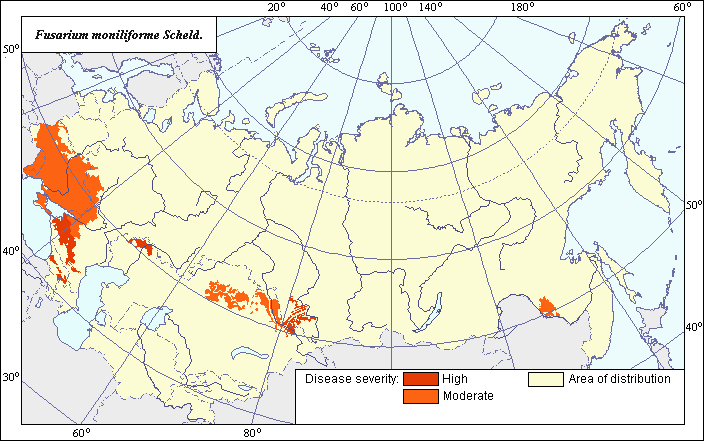Diseases
Distribution and severity of Fusarium Ear Rot (Fusarium moniliforme Scheld.)
 Object description Download GIS-layers
Object description Download GIS-layers
Authors:
Specialist-biologist M.M. Levitin,GIS-specialist M.I. Saulich.
Date of creation:
18.03.2005Scale:
1:20 000 000Accuracy of map:
Map was created based on materials of maps of natural scale 1: 33 000 000.Projection:
"Alber.s Equal Area Conic for the USSR", 9, 1001, 7, 100, 0, 44, 68, 0, 0Basic contents:
Vector map. Area of species distribution and zones of disease severity are shown by polygons.Accuracy of classifier:
Zones of disease severity were allocated according to the following sources: Geshele & Vinogradova (1957), Nemlienko (1957), Kalashnikov & Shapiro (1962), Ivashchenko et al. (2000). The zones of high severity are characterized by 60-70% ears being affected (Nemlienko, 1957). The other zones established were zones of moderate severity. In these zones 7-10% ears are affected (Nemlienko, 1957). The zones characterized by low severity were not presented, because even a minimal infection leads to an accumulation of carcinogenic mycotoxins known as fumonisins in grain.Method of map production:
Scientists were given maps with boundaries of Oblasts and arable lands. After reviewing historic literature, species distribution was hand drawn on maps. If data were on the Oblast-level, distribution is on the Oblast level. In some cases, Oblast.s are further refined by boundaries of the Arable Land Map (Koroljeva et al., 2003). Hand drawn maps were scanned, georeferenced and vectorized. According to the following sources the disease is most harmful in the Northern Caucasus, in Central regions of the European part of Russia, in Siberia, Altai Territory, in the Far East, Ukraine, Georgia, and Byelorussia: Geshele & Vinogradova (1957), Nemlienko (1957), Ivashenko et al. (2000). The disease can continue its development during ear storage under conditions of high humidity and insufficient aeration (Kalashnikov & Shapiro, 1962).Reference citations:
Geshele E.E., Vinogradova N.I. 1957. Corn diseases in West Siberia and their control. Proc. of Omsk Agricultural Institute, 22(1): 117-124. (In Russian)Ivashchenko V.G., Shipilova N.P., Sotchenko E.F. 2000. The most damaging disease of seeds and ears of corn. Agro XXI, 7: 6-7. (In Russian)
Kalashnikov K.Ya., Shapiro I.D. 1962. Pests and diseases of corn. Leningrad: Sel.khozgiz. 189 p. (In Russian)
Koroljeva IE, Vilchevskaya EV, Ruhovich DI. 2003. Digital Arable Land Map. Laboratory of Soil Information of the Dokuchaev Soil Institute, Moscow, Russia [Based on: Yanvareva LF. (ed.), Martynjuk KN., Kisileva NM. 1989. Map of Land Use, Faculty of Geography, Moscow State University, Moscow, Russia.].
Nemlienko F.E. 1957. Diseases of maize. Moscow: Sel.khozgiz. 230 p. (In Russian)
Rheeder J.P., Marasas W.F.O., Vismer H.F. 2002. Production of fumanisin analogs by Fusarium species. Applied and Environmental Microbiology, 68: 2101-2105.

